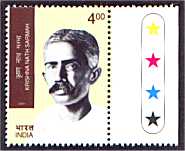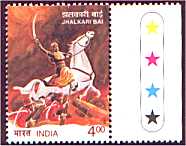 |
stamps issued in 2001 july |
 |
stamps issued in 2001 july |
[Home][About Us][Membership][Member
List][Links][Kids][Feedback][Magazines][Dealers][Societies][Articles][WhatsNew]

|
PERSONALITY SERIES Syama Prasad Mookerjee (I901-1953) inherited a rich tradition of nationalism and fearlessness from his illustrious father, Sir Asutosh Mookerjee. A brilliant academic, he became the youngest Vice-Chancellor of the Calcutta University in 1934. He took interest in politics very early and was one among the leading lights of the Hindu Mahasabha. Though he became the Finance Minister of Bengal in 1941, he resigned from the post in protest against the British policies, and continued to oppose the British colonial rule till India attained independence. When the partition of India became inevitable, he was largely instrumental in retaining parts of Bengal and Punjab in the country. In independent India, he was part of the first National Government of 1947, but resigned from it in 1950 in disagreement with the policy towards Pakistan. In 1951 he organised a new political party, the Bhartiya Jana Sangh. He argued strongly for the complete integration of Jamrnu and Kashmir with India and was arrested while on a campaign in Srinagar in 1953. He died while in custody. He was a nationalist to the core and "country comes first" was his watchword. C. Sankaran Nair (1857-1934) hailed from an aristocratic family in north Kerala. Making a mark as an eminent lawyer early in his career, he went on to become a Judge of the High Court of Madras, in which capacity he was considered one of the ablest. Despite his admiration for the British democratic institutions, Sankaran Nair was an ardent nationalist who had the courage to speak out for his country. He was elected President of the Indian National Congress in 1897. His notes of dissent as a member of the Viceroy's council in 1919 created quite a sensation and when he resigned from the Council in the same year in protest against the British atrocities in Punjab, he received an unprecedented ovation. U Kiang Nongbah ( -1862) was a great freedom fighter of the Jaintia hills of Meghalaya, who lived and fought his epic struggle against the British during the first War of Independence (1857) and after. Even as a child, his spirit of rebellion was aroused by the stories of the dubious methods employed by the British to annex Jaintia. As he grew up, he was consumed by a passion to drive out the foreign invaders from his motherland. He was quick to realise that a disciplined fighting force was necessary to counter the mighty military machine of the British. Opportunity came his way when he was elected leader of a group of headmen and he went on to lead the war of liberation of Jaintia against the British. Kiang Nongbah and his men launched a guerilla war against the British forces, humiliating their superiority in arms and trained men through ambushes. Kiang was badly injured in one of the bloodiest battles. He was captured by the British while he was recuperating and later hanged on the 30th of December, 1862. Krishna Nath Sarmah (1887-1947) was a renowned nationalist and social reformer from Assam. After graduating in Science and Law, he had started legal practice in 1917. However, heeding to the call of Mahatma Gandhi he joined the freedom struggle, renouncing a flourishing practice and a promising career. As one among the founders of the Congress in Assam and with active presence in it at the national level, he concentrated on the constructive work and never aspired for any position. He played an active role in the promotion of Khadi, propagation of Hindi and fight against untouchability in Assam. The opening of his private ancestral temple to the Harijans was an epoch making event. He also had to suffer imprisonment at the hands of the colonial rulers, but made the most of his incarceration by giving expression to his literary talents by translating books like the "Ramcharit Manasa" and "Gita" into Assamese.
|
| Chandragupta
Maurya Chandragupta Maurya Though historians often credit the Nandas of Magadha for being the first empire builders of India, it was with Chandragupta Maurya, the young adventurer who unseated the Nandas in 321 B.C. that the imperial idea found a definite expression. Indika, the memoirs Megasthenese, the Greek Ambassador to the Court of Chandragupta Maurya and Arthashastra the compendious work of Chanakya are the main sources from which we can learn and infer about the life and times of Chandragupta Maurya. It is believed that Chandragupta hailed from a humble background. He did not have the military might to match the Nandas, yet managed to acquire the throne and keep it, making use of the strategies of Chanakya, his chief advisor. Leaving Kerala, Tamil Nadu, and parts of north-eastern India, the Mauryas ruled over the whole of the subcontinent. In the north-west they had sway over certain areas which were not included even in the British empire. Chandragupta Maurya was a far-sighted ruler. He not only expanded his territories, but also established a well organised administrative system and gave it a sound financial base, thus laying the foundation for an enduring empire. He had set a high ideal and is stated to have believed that his happiness lay in the happiness of his subjects and that in their troubles lay his troubles. Chandragupta's reign lasted for about 25 years. According to Jain tradition, he adopted Jainism, having been influenced by the saint Bhadrabahu. He is believed to have abdicated the throne in favour of his son Bindusara and pursued a spiritual life thereafter.
|
 |
 |
Jhalkari Bai Though the recorded history does not reveal much about the antecedents or heroic exploits of Jhalkari Bai, she is a living memory in the folklore of the Bundelkhand region even today. Jhalkari was a village girl who had to take charge of the household chores in her childhood itself, following the early loss of her mother. It is said that she once had an encounter with a tiger while collecting firewood in the jungle and killed it with her axe. Jhalkari also bore an uncanny resemblance to Rani Lakshmi Bai of Jhansi, because of which the Rani took a special liking to her and inducted her into the women's wing of her army. The people of Jhansi resented the annexation by the British. They rallied around Rani Lakshmi Bai and resolved to take up arms to uphold the independence of their state. In 1858, there were several attacks on the Jhansi fort by the British and their native allies. The Rani marshalled her forces well and repulsed these attacks. It is said that when the fall of the fortress became imminent, Jhalkari Bai and some generals convinced Lakshmi Bai to escape quietly with a handful of supporters. As a ploy to deceive the British, Jhalkari dressed up like the Rani and took command of the army. The British found out the truth too late, as the Rani had covered a considerable distance by then. Though Jhalkari Bai was forced to surrender, it is believed that the British military officers, who were impressed by her loyalty, courage and fighting prowess treated her with respect and freed her.
|
Ovr Sz - Overall Size Pr Sz - Printed Size
[Home][About Us][Membership][Member List][Links][Kids][Feedback][Magazines][Dealers][Societies][Articles][WhatsNew]
Copyright
(c) Dakshina Kannada Philatelic Association
http://www.geocities.com/dakshina_kan_pa